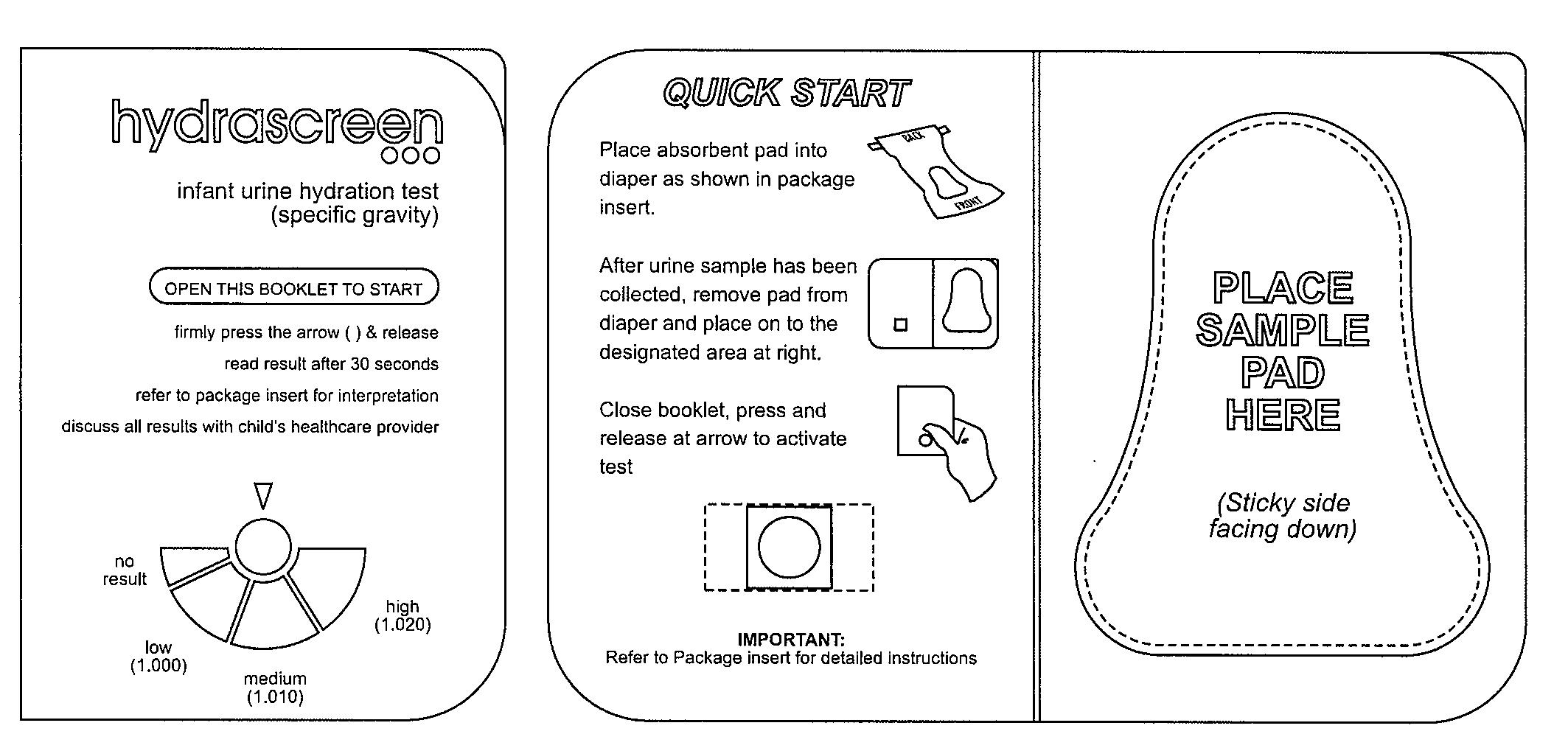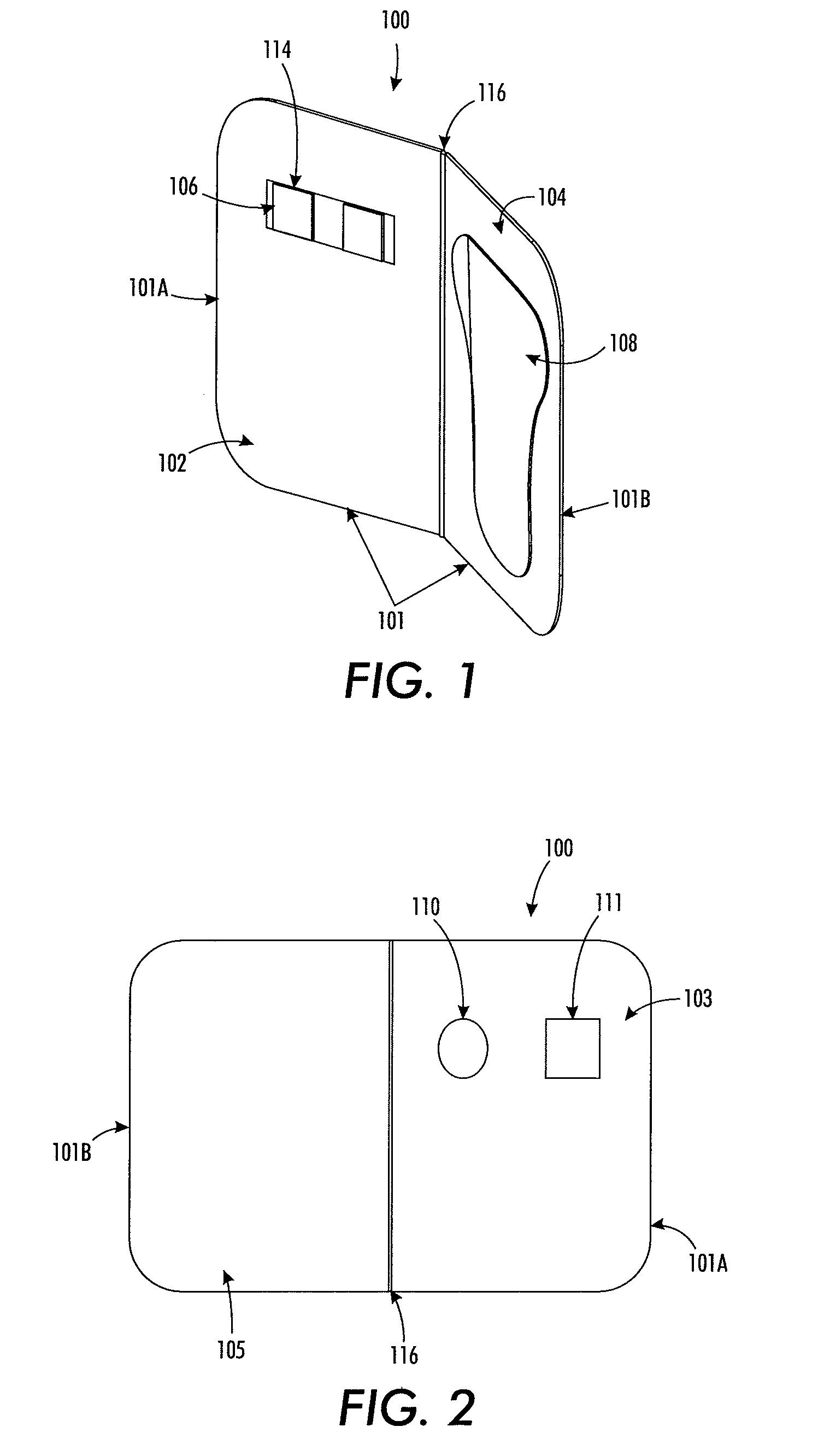All of these existing means of collecting urine present problems when the subject is unable to actively participate in the collection process (e.g., is an infant or incontinent adult).
Collection into a specimen container is impractical, while the invasive techniques of catheterization and aspiration are painful and
pose risks of injury and infection.
Urine bags are notoriously unreliable, frequently leaking the collected specimen before it can be retrieved.
Removal of the bag from the
skin in the genital region is also painful and
distressing for family members to observe.
None of these methods is currently in routine use in the
home environment; as a result, the collection of urine for
home testing of any kind represents a technology that is essentially unavailable to infants, incontinent adults, and their non-skilled caregivers.
Transportation of the specimen over such distances presents opportunity for a number of undesirable events to occur prior to actual testing of the specimen.
Infection risk to the caregiver,
contamination, adulteration, or other alteration of the specimen is increasingly likely as the distance and time between collection and testing increases.
In addition, opportunities for errors in
specimen identification multiply with time, distance, and the number of individuals who
handle the specimen along the way.
Direct self-testing of urine eliminates many of these constraints and is available for numerous tests, but none of these are suitable for use in individuals who cannot provide a volume of liquid urine for testing.
Application of liquid to the testing device offers additional opportunities for use errors,
contamination, and other events that can adversely affect the outcome of the test.
This degree of handling of liquid specimens offers opportunity for
contamination, adulteration,
spillage, and incorrect test results, for example.
Again, all such existing means for
urine testing require the application of a liquid quantity of the specimen to be tested, and as such are unavailable for use in individuals who cannot produce a liquid sample in a controlled fashion, such as those wearing diapers.
Users must therefore compare the actual result with the reference chart, which introduces opportunities for error and imprecision in reading results.
Yet again, all such existing means for reading and recording of test results are unavailable for use in individuals who cannot produce a liquid sample in a controlled fashion, such as those wearing diapers.
Reporting of test results provides another opportunity for the introduction of error, especially when results are subjective in nature, and / or when at least one result indicates an apparently “normal” value.
Because no
single test provides comprehensive information about a
health condition, lack of reporting any result, even a normal one, may result in an adverse outcome.
Yet again, all such existing means for reporting of test results are not applicable for use in individuals who cannot produce a liquid sample in a controlled fashion, such as those wearing diapers.
Interpretation of test results without direct and timely communication between the individual performing the interpretation and the individual affected by the result offers additional opportunity for error and
adverse outcomes.
Delayed interpretation can mean loss of an opportunity to intervene and interrupt a
disease process early in its course.
Interpretation by the patient or patient's unskilled representative poses the risk of incorrect or biased interpretation based on a host of physical and psychological factors entirely unrelated to the test (for example a reluctance to undergo further testing or other procedures).
Yet again, all existing means for interpreting test results are unavailable for use in individuals who cannot produce a liquid sample in a controlled fashion, such as those wearing diapers.
Unfortunately, all known means for acting on test results in such a fashion are unavailable for use in individuals who cannot produce a liquid sample in a controlled fashion, such as those wearing diapers (and in the case of the example given here, such individuals represent up to 50% of people in whom such testing might be considered).
Most importantly, no method or device currently exists for the collection of small quantities of urine from diaper-wearing individuals and direct introduction of that specimen to a testing apparatus.
The absence of such a method and device makes a variety of urine tests virtually unavailable in infants and other diaper-wearing individuals, resulting loss of potentially valuable health status information, or, alternatively, in the use of other, more invasive forms of testing, or, yet again, in the potential application of unnecessary forms of treatment in the absence of such
health information.
Light
refractometry is fairly easily performed by a skilled individual, but the equipment is costly and must be maintained and calibrated consistently.
Modern highly-absorbent diapers, however, retain urine so tightly within their
absorbent material that insufficient urine can be expressed from the diaper to produce a valid test result.
This pH sensitivity is a
potential source of at least minor errors in SG determination by this method.
As a result of these various limitations in existing methodologies, the determination of urine SG, a valuable contributor to the evaluation of
hydration status, is essentially unavailable in the
large population of people who would benefit the most from its use, for example, infants and other diaper-wearing individuals with diarrheal illness who are at risk for
dehydration.
Numerous types of devices and methods have been proposed for body liquid collection and analysis, but a practical, commercially viable approach to the problems discussed above, has not been found, as the following review of certain types of prior art devices and methods demonstrate.
The use of a chemical reactive means that is integrated in a functional disposable (e.g. diaper) creates a number of problems in this approach.
For example, the need to visually read the same surface of the chemically reactive means that is exposed to excrement provides no protection for the chemical reactive means against additional chemical interferences that exist within the excrement.
The Everhart et al. device allows the excrement to contact the same surface of the chemical reactive means that is visually inspected, which provides no protection against the optical interferences that exist within the excrement, such as
optical reflectance,
optical refraction, or
turbidity, which can unpredictably and adversely affect the optical characteristics of the surface of the chemically reactive means and the proper interpretation of the results of the chemically reactive process.
The Everhart et al. device may also create a health /
biohazard risk for the patient.
Because the chemically reactive means are integrated in the
sample collection means, the device requires that chemical reagents be placed into direct contact with the
skin of the patient, with the
resultant potential for adverse reaction with the
skin.
The ability of all excrement to contact the integral chemical reactive means, for example, makes it possible for a urine-based test to be activated by fecal matter, and vice-versa, without being apparent to the user, which could result in incorrect diagnosis and treatment.
The Everhart et al. device does not provide feedback to the user to identify this potentially dangerous condition.
Although Albarella et al. attempt to increase the ease of analysis of fluids, there are still numerous problems related to the use of
test strips and reagents as discussed below.
This positional sensitivity makes the Albarella device prone to user-related errors.
Because sample fluids have optical properties such as reflectance,
refractive index, color and / or
opacity, it is possible for these fluids to alter the appearance of the reference colors and jeopardize accurate interpretation of the results produced by the activated
reagent pad.
This provides no protection against optical interferences, such as variations in the
optical reflection, refractive characteristics, or variable
turbidity of the fluid placed on the surface of the chemically reactive means.
Albarella's device does not provide any means to inform the user that the test has failed.
For example, transfer of a sample to the
reagent pad that contains a low quantity of the
reagent of interest (e.g. a
low glucose urine sample) and therefore does not activate the reagent pad would produce the same result as a failure to deliver sample to the reagent pad.
Variation in
ambient humidity, for example, introduces an unpredictable amount of sample
evaporation and evaporative cooling, both of which can affect sample and reagent reaction
kinetics in unpredictable ways, thereby increasing the potential for an incorrect result and inappropriate treatment.
For example, tests for HIV are often designed so that when failure occurs, the failure produces a greater number of false positives since a FP can trigger result
verification and at worst unnecessary treatment, whereas a
false negative result can withhold treatment leading to further progression and proliferation of the diseases with potentially catastrophic results.
Albarella's device provides no means to bias test results, where necessary.
The Albarella device also does not preserve identical spatial relationships between the reagent pad and multiple reference colors.
Another significant problem with the Albarella et al. device is the requirement for the user to directly
handle the sample fluid, such as by dropper or
pipette.
There is also moderate potential to mis-register the
fluid specimen to the test device.
Finally, the limited area of the reagent pad and reference color areas makes it very difficult to use this area to contain instructions that can be reliably utilized to instruct the user how to properly obtain and analyze the excrement sample and act on the results.
The Blake et al. device is quite complicated and discourages private use in a
home setting.
These requirements not only make the device more difficult to use but also exposes the user to an enhanced level of
biohazard.
It also utilizes a very small chemically activated surface, the absence of a color
comparator, and the potential for the optical properties of the sample to adversely affect the developed color of the chemically activated surface as described earlier, makes it very difficult to accurately interpret the results of the
chemical reaction.
Kikuchi is complex and requires the use of
toilet-sized device, which places severe limitations on device
miniaturization, cost, and general availability.
The Kikuchi device also requires the
active participation and prior knowledge on the part of the end-user, which precludes the device from being used by infants, the incapacitated elderly, or otherwise uncooperative or disabled patients.
The completely automated operation described by Kikuchi does not permit user intervention and control, such as to conduct
quality assurance checks (e.g. verify adequate
sample volume or absence of stool interference).
Alternatively, a patient or care-giver must be exposed to potentially dangerous or caustic chemicals, with which they have little knowledge.
 Login to View More
Login to View More  Login to View More
Login to View More 


